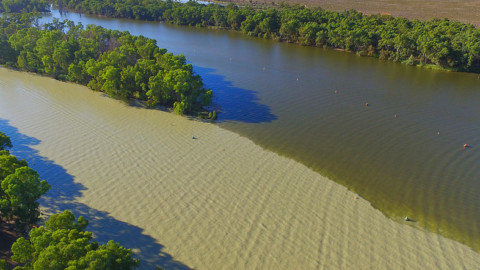A new flood impact tool was created in early 2022 to aid in South East Queensland’s February flood recovery, enabling rapid disaster recovery assessments and applications for affected residents.
Created by not-for-profit environmental organisation Healthy Land & Water, South East Queensland residents used the online form to upload local information and photos to help the organisation better understand flood impacts to natural areas and project sites.
The flood impact tool enabled Healthy Land & Water to build an image of the level of impact in each area and the rectification that may be required even before the flood waters had receded. As a result, the organisation was able to quickly assess the affected areas.
Unexpectedly, the tool also started to show that project sites where works had been undertaken fared better during the extreme weather events.
This was much-needed good news at a time when the flooding had caused widespread devastation throughout the region, including tragic loss of life and extensive damage to homes, businesses, infrastructure and the environment.
The tool was needed time and time again over the months that followed, as more extreme rain events caused further damage to already vulnerable sites. The tool clearly showed the environmental impacts of the floods, including erosion, habitat loss, weed dispersal, and the release of harmful pollutants.
Queensland’s coastlines were also inundated with ‘white spill’ – tiny polystyrene beads from the breakup of Brisbane River pontoons which came adrift during the floods.
Creating a durable region
The increasingly observable impacts of climate change are set to intensify and become more frequent over the coming decades, which will have widespread implications for Queensland’s environments.
The recent flooding events, so close to the devastating fire events in recent years, were a stark and timely reminder that something needs to be done. Many have voiced their frustration, as strategies to help lessen the impact of future floods were identified after the 2011 floods, but have never been actioned.
The most recent floods have been a stark reminder that more proactive resilience work is needed throughout the region, rather than the current reactive system of activating disaster funding after the fact.

Flood impact tool
Healthy Land & Water said that ensuring Queensland remains disaster ready and improving climate change resilience will require large-scale leadership and collaboration.
CEO of Healthy Land & Water, Julie McLellan, said, “To create disaster resilient regions, we must have proactive investment in on-ground projects that increase resilience, reduce flood risk and enhance waterways and landscapes, rather than governments simply pouring millions into clean up and recovery after the event.
“Healthy ecosystems can help boost the resilience of our communities and support our region’s ability to adapt to a changing climate.
There is a growing body of evidence for nature-based solutions for climate change mitigation and adaptation. “We know that active and targeted investment in flood preparedness could greatly increase resilience and reduce the impact of future extreme events.”

Cost effective strategies
Healthy Land & Water estimates that investing in measures that reduce flood risk by building ecosystem resilience is three to five times more cost effective than trying to repair damage and impact after an extreme flood event, like South East Queensland’s February floods.
“We have 20 years of data from our monitoring program for the region and evidence from the many thousands of projects we’ve deployed which are giving us clear sign-posts of what needs to be done to make our region more resilient to extreme events,” Ms McLellan said.
“The missing piece is the large-scale proactive investment to make it happen. This needs a complete turnaround in thinking – and that’s going to be a hard conversation because our governmental systems are not set up that way currently – but the potential benefit for the region makes it essential to achieve, and the sooner the better.”
Channelling investment into resilience is not just an economically sound approach, it will also have untold positive social, environmental and cultural benefits. The learnings can be applied nationally and globally.
The flood impact tool can be accessed here: https://survey123.arcgis.com/share/cb27c4ce9b6545b7ab287b6ad59726c3

For more information, visit https://hlw.org.au/.
Featured image courtesy of Healthy Land and Water. L-R: Healthy Land and Water Chief Executive Officer Julie McLellan, Minister for the Environment and the Great Barrier Reef, Meaghan Scanlon MP, Healthy Land and Water Clean Up Program Crew Leader, Jim Hinds, and Healthy Land and Water Team Leader, Rachael Nasplezes.















